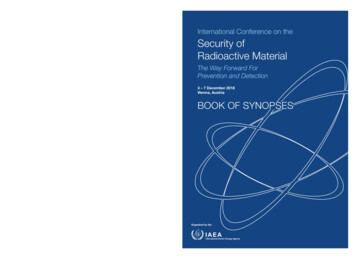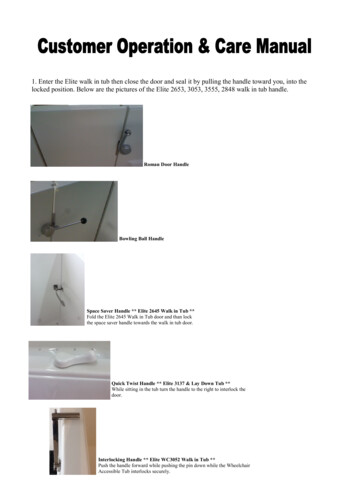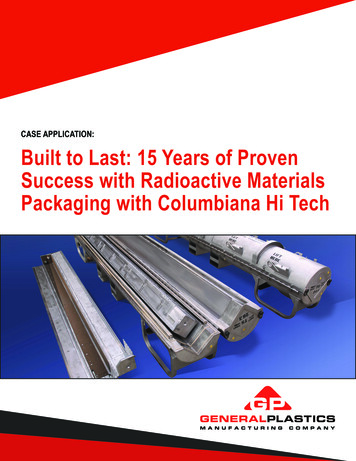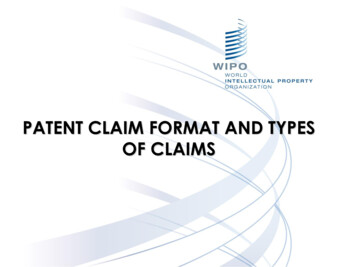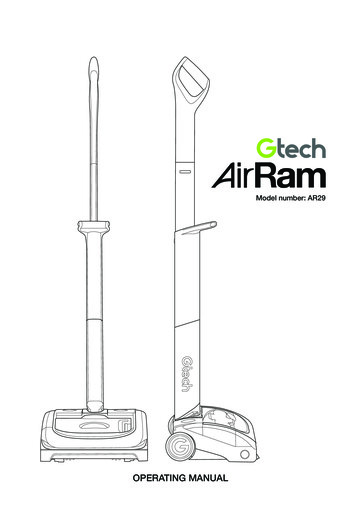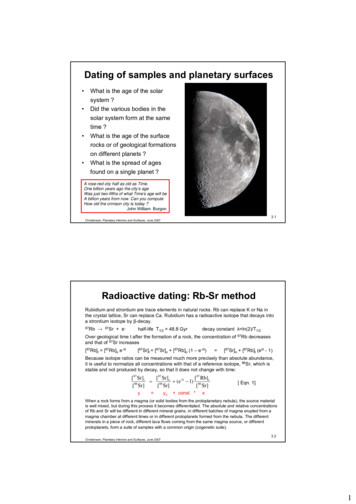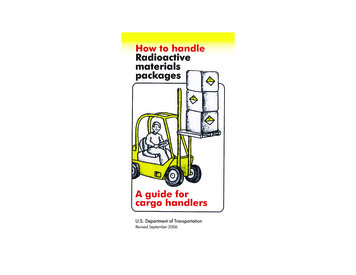
Transcription
How to handleRadioactivematerialspackagesA guide forcargo handlersU.S. Department of TransportationRevised September 2006
Copies of this guide may be obtained fromU.S. Department of TransportationPipeline and Hazardous Materials Safety AdministrationOffice of Hazardous Materials Initiativesand Training400 Seventh Street, S.W., PHH-50Washington, D.C. 20590http:// hazmat.dot.gov - click on “Training Information”PHH50-0089-0107
How to handleRadioactive materialspackagesA guide forcargo handlersPipeline andHazardous MaterialsSafety AdministrationRevised September 2006
INTENTIONALLY LEFT BLANK2
Radioactive Materials PackagesYou can recognize many radioactive materialspackages by their labels.A RADIOACTIVE WHITE-I label means practically no radiation outside the package, while aRADIOACTIVE YELLOW-II label means some radiation outside the package. The RADIOACTIVEYELLOW-III label is for higher radiation levelsthan RADIOACTIVE I and II. The FISSILE whitelabel indicates special handling instructions foundon page 9. Packages with limited quantities ofradioactive materials do not have these labels.3
Limited quantities of radioactive materials can beidentified by the markings: UN2908,UN2909, UN2910, or UN2911. If thesepackages are to be shipped by air, they willhave a “Radioactive materials, ExceptedPackage” label.Most radioactive materials packages containradioactive drugs that are being transported tohospitals.4
The radioactive drugs are given to patients forthe detection and treatment of disease.Radioactive materials are also used by industryand by research laboratories.Packages of radioactive materials are safe tohandle under normal conditions. Studies showthat cargo handlers get very little radiationexposure from handling them.5
However, you should always follow good workhabits that will prevent unnecessary exposure toany hazardous sources, including radiation.The radiation dose you receive depends on howlong you stay near a radioactive materialspackage. It also depends on how close you areto the package, because the radiation level dropsoff rapidly as you get farther away from thepackage.Therefore, the basic rules to follow to preventunnecessary radiation exposures are called theTIME and DISTANCE rules. They are given on thenext four pages.6
Time RuleKeep contact time with package short Do not take rest periods near radioactivematerials packages. Do not use packages as meeting places. Do not do time-consuming tasks, such aspaperwork, near packages. Handle packages without delay whenmoving them from one place to another.Do not hang around packages.7
Do not socialize near packages.Do not use packages as a desk.8
Distance RuleKeep packages some distance awayfrom you and other people When moving packages a long way, usea cart or truck that will let you leave a fewfeet between you and the radioactivematerials packages. Position radioactive materials packagesso people don’t have to stand next to themwhile handling other packages. When there is a convenient choice oflocations, store packages farthest fromareas occupied by people. Do not store packages with transportindexes (TIs) or criticality safety indexes(CSIs) that add up to more than 50 in anygroup. Groups of such packages must bestored 6m (20 ft) from all other groups ofsuch packages.Use a cart to keep packages some distance awayfrom you when moving them a long way.9
Stow packages away from areas occupied bypeople.Don’t place packages in the cab with the driver.10
In case of accidents, you can receive higherexposures if you do not handle the situationproperly. The steps you should follow if there isan accident are given on page 12.11
What To Do In Case of an AccidentWhere a package containingradioactive material may havebeen damaged1. Stay away from the package and donot touch it.2. Keep other people away from thepackage.3. Notify your supervisor. He or she willcall for help.4. Tell anybody who may have touched thepackage to go to a control point tobe checked by radiation protectionspecialists.5. Wash your hands thoroughly if youtouched the package or objects near it.6. Have yourself checked by a radiationprotection specialist before you leavework.12
Do not clean up the area where the accidentoccurred. This must be done under the directionof specialists.13
Questions and AnswersThe rest of this booklet contains answers to somecommon questions asked by cargo handlers.14
Q Is it safe to handle packages ofradioactive materials?A Packages of radioactive materials are safeto handle under normal conditions. Theradiation exposure received from handlingthese packages is not likely to cause anyadverse health effects.However, you should still try to avoid unnecessary radiation exposure by followingthe Time-Distance rules described earlier inthis booklet.In case of an accident, it may or may notbe safe to handle radioactive materialspackages. Be sure to stay away from apackage that has been badly damaged oris leaking.15
Q Is it true that everybody isexposed to radiation?A Yes, everybody in the world receives asmall amount of radiation exposure at alltimes. Radiation is given off constantly byradioactive materials all around us—in theground, in the walls of buildings, even inour own bodies. In addition, the earth isbombarded by radiation from the sun andfrom outer space, known as cosmicradiation.The additional radiation doses cargohandlers receive in a year from handlingradioactive materials packages are generally less than the doses received from thesenatural sources.FROM BUILDINGMATERIALSFROMOUTER SPACEFROM INSIDETHE BODYFROMTHE GROUNDRadiation exposure from the environment.16
Q Can a person or food becomeradioactive from being nearpackages of radioactive material?A You cannot become radioactive fromthe radiation given off from packages ofradioactive materials. The exposure toradiation stops when you move away fromthe packages.The same thing is true for food. If lobstersare stacked next to a radioactive materialspackage, they will not become radioactiveand it is not dangerous to eat them.The only way you can get anyradioactivity on you is if the packagingfails and the radioactive material leaksout and comes in contact with you. If youthink this has happened, contact yoursupervisor. The supervisor will arrange tocheck you with a radiation meter and willsee that any radioactive material foundis cleaned up properly (usually with soapand water).17
Q How serious is leakage ofradioactive liquid or powder froma package if there is an accident?A There is a chance that radioactive materials that leak from a broken package canbe breathed in or swallowed. Even if somegets into your body, however, it is notnecessarily dangerous. Remember thatmost of the packages shipped containradioactive drugs that are deliberatelygiven to patients by doctors. Someradioactive materials are more dangerousthan others. However, the more dangerousradioactive materials are shippedinfrequently and must be contained inespecially strong packages. It is unlikelythat the contents will leak out, even if thepackages are dropped or damaged.18
GlossaryActivity is a measure of the quantity ofradioactivity emitted by a radioisotope and isused to determine the amount of radioactivematerial which may be transported in varioustypes of packagings.Content (indicated on the radioactive labels)is the identification of the radioactive materialinside the package.Criticality Safety Index (CSI) is a numberwhich is used to provide control over theaccumulation of packages, overpacks, or freightcontainers that contain FISSILE material.Radioactive materials spontaneously andcontinuously emit ionizing radiation, that can beharmful to the health of humans and animals andcan affect photographic or X-Ray film. This radiation cannot be detected by any of the humansenses (sight, smell, hearing, touch, or taste), butit can be detected and measured with suitableinstruments.Transport Index (TI) is a single numberassigned to a package, overpack, or freightcontainer to provide control over radiationexposure and used to designate the spacingrequirements to be exercised by thehandler/carrier during transportation andstorage.19
INTENTIONALLY LEFT BLANK20
INTENTIONALLY LEFT BLANK21
HowToRadioactive.indd, Spread 1 of 12 - Pages (21, 1) 1/18/2007 10:14 AMTO LEARN MORE.For information about hazmat publicationsand other training materials:How to handleRadioactivematerialspackagesVisit our website:http://hazmat.dot.govWrite:Office of Hazardous MaterialsInitiatives and Training1200 New Jersey Avenue, SEPHH-50Washington, DC 20590-0001Fax: (202) 366-7342Email: training@dot.govOr Phone: (202) 366-2301For information aboutHazmat RegulationsContact our Hazmat INFO-LINEE-mail: infocntr@dot.govA guide forcargo handlersU.S. Department of TransportationRevised September 2006
RADIOACTIVE YELLOW-II label means some ra-diation outside the package. The RADIOACTIVE YELLOW-III label is for higher radiation levels than RADIOACTIVE I and II. The FISSILE white label indicates special handling instructions found on page 9. Packages with limited quantities of radioactive materials do not have these labels. 3
